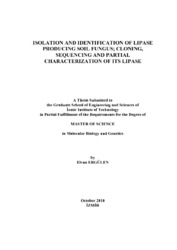Please use this identifier to cite or link to this item:
https://hdl.handle.net/11147/3068Full metadata record
| DC Field | Value | Language |
|---|---|---|
| dc.contributor.advisor | Arslanoğlu, Alper | - |
| dc.contributor.author | Ergülen, Elvan | - |
| dc.date.accessioned | 2014-07-22T13:50:49Z | - |
| dc.date.available | 2014-07-22T13:50:49Z | - |
| dc.date.issued | 2010 | - |
| dc.identifier.uri | http://hdl.handle.net/11147/3068 | - |
| dc.description | Thesis (Master)--Izmir Institute of Technology, Molecular Biology and Genetics, Izmir, 2010 | en_US |
| dc.description | Includes bibliographical references (leaves: 37-42) | en_US |
| dc.description | Text in English; Abstract: Turkish and English | en_US |
| dc.description | xi, 45leaves | en_US |
| dc.description.abstract | Lipases are well known enzymes which catalyze the hydrolysis of long chain triglycerides. Contrary to many other enzymes, lipases show a wide range of substrate specificity and remarkable levels of activity and stability in non-aqueous environments. Therefore, they have a great potential in many industrial applications such as detergent industry, paper and food technology, as biocatalysts for the synthesis of organic intermediates. Lipases can be obtained from animals, plants as well as from natural and recombinant microorganisms in good yields. The aim of this thesis was isolation and identification of a lipolytic fungus and purification and characterization of its lipase enzyme. For this purpose, a lipolytic fungus was isolated from soil sample collected from Kula. Lipase activity of this fungus was detected rapidly by Rhodamin B - olive oil plate assay. The lipolytic fungus was identified by 28S rRNA gene sequence analysis and determined to be a strain of Rhizopus stolonifer. Because this lypolytic fungus was isolated from soil sample collected from Kula, it was named as R. stolonifer K45. This fungus showed best growth at 25°C and did not grow above 35°C. In the second part of the study, lipase enzyme of the fungus was partially purified but previously, optimum time and carbon source for lipase production was determined. According to this, optimum lipase production was obtained at 7th day of growth in the media including only olive oil as carbon source. Glucose when included in the growth media was observed to reduce the amount of lipase. In order to purify fungal lipase, aceton precipitation (30 %) and ultrafiltration methods were used. Lipase activity assay was performed spectrophotometrically. The chain length specificity of this lipase was detected and highest activity was observed towards p-NP laurate. The effect of different temperature and pH values on lipase activity and stability was also determined and optimum temperature and pH were found 45°C and pH 8, respectively. Furhermore, different organic solvents and metal ions were tested on lipase activity. The lypolytic enzyme was inhibited by n-hexane. However, methanol and DMSO were detected to enhance the lipase activity. | en_US |
| dc.language.iso | en | en_US |
| dc.publisher | Izmir Institute of Technology | en_US |
| dc.rights | info:eu-repo/semantics/openAccess | en_US |
| dc.subject.lcsh | Lipase--Biotechnology | en |
| dc.subject.lcsh | Enzymes--Biotechnology | en |
| dc.subject.lcsh | Enzymes--Industrial applications | en |
| dc.title | Isolation and Identification of Lipase Producing Soil Fungus; Cloning, Sequencing and Partial Characterization of Its Lipase | en_US |
| dc.type | Master Thesis | en_US |
| dc.institutionauthor | Ergülen, Elvan | - |
| dc.department | Thesis (Master)--İzmir Institute of Technology, Molecular Biology and Genetics | en_US |
| dc.relation.publicationcategory | Tez | en_US |
| dc.identifier.wosquality | N/A | - |
| dc.identifier.scopusquality | N/A | - |
| item.languageiso639-1 | en | - |
| item.cerifentitytype | Publications | - |
| item.openairetype | Master Thesis | - |
| item.openairecristype | http://purl.org/coar/resource_type/c_18cf | - |
| item.fulltext | With Fulltext | - |
| item.grantfulltext | open | - |
| Appears in Collections: | Master Degree / Yüksek Lisans Tezleri | |
Files in This Item:
| File | Description | Size | Format | |
|---|---|---|---|---|
| T000874.pdf | MasterThesis | 837.18 kB | Adobe PDF |  View/Open |
CORE Recommender
Page view(s)
360
checked on Jun 10, 2025
Download(s)
164
checked on Jun 10, 2025
Google ScholarTM
Check
Items in GCRIS Repository are protected by copyright, with all rights reserved, unless otherwise indicated.